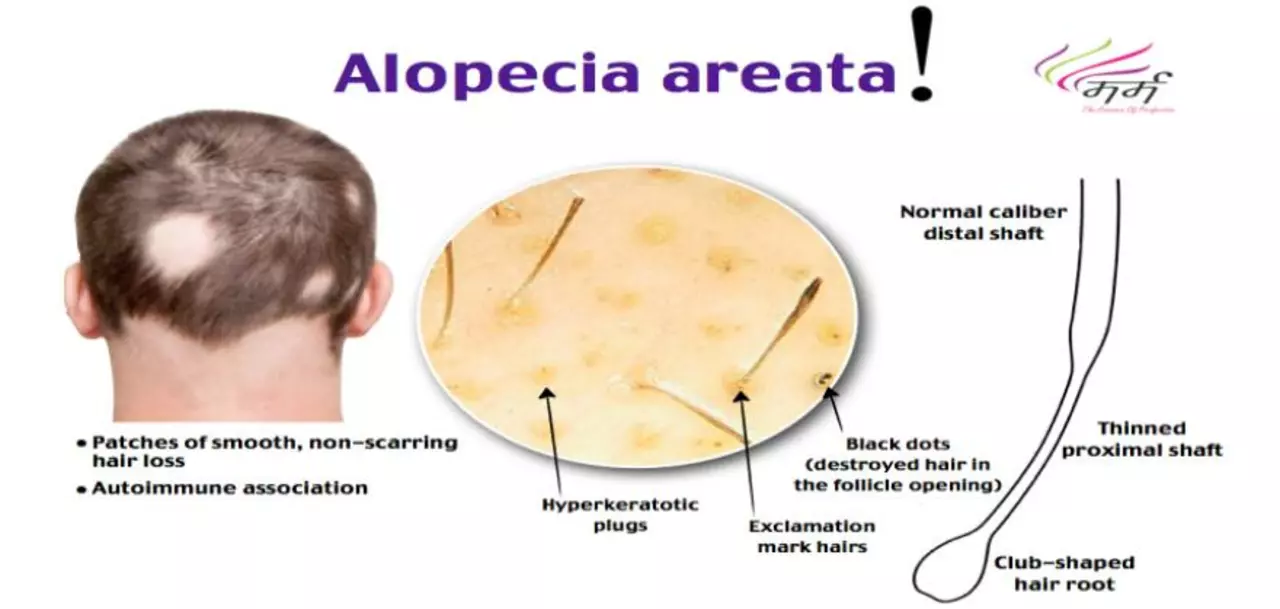Alopecia Areata: Quick, Practical Help for Patchy Hair Loss
Noticing round patches of hair missing? That’s classic for alopecia areata — an autoimmune condition where the immune system attacks hair follicles. It can start suddenly, affect any age, and shows up as one or more smooth, hairless spots. The course is unpredictable: hair can regrow on its own or the condition can spread.
What causes it and how it's diagnosed
Alopecia areata happens when immune cells target hair follicles. Risk factors include a family history of autoimmune disease, other autoimmune conditions (like thyroid disease), and sometimes a recent illness or high stress. Diagnosis is usually clinical — your doctor looks at the pattern and may pull a few hairs to inspect. If things are unclear, a dermatologist might do a small scalp biopsy or blood tests to check for thyroid or other autoimmune issues.
Common and effective treatment options
There’s no one-size-fits-all cure, but several treatments can encourage regrowth or slow progression. Topical corticosteroids (creams or ointments) are often used for small patches. For more stubborn areas, dermatologists inject a steroid called triamcinolone directly into the bald spots — that often helps regrow hair over weeks to months.
Topical minoxidil (Rogaine) can boost regrowth when used regularly. For more extensive or resistant cases, doctors may use topical immunotherapy (contact allergens like DPCP) to redirect the immune response.
Systemic options include oral steroids for short bursts and newer drugs called JAK inhibitors (tofacitinib, ruxolitinib). JAK inhibitors have shown impressive results for many people, but they carry risks and need close medical monitoring.
Non-medical options matter too: wigs, hairpieces, scarves, and cosmetic solutions can restore confidence while you’re treating the condition. Camouflage powders and microfibers hide small patches quickly for social events.
If you consider online medication, be cautious. Some treatments, like triamcinolone injections, should only be given by a trained clinician. Buying drugs online without a prescription or proper guidance can be unsafe.
How long before you see changes? For injections and topical steroids, expect to wait 6–12 weeks to notice regrowth. JAK inhibitors may show results in a few months. Hair regrowth can be partial or full; relapses happen.
Practical next steps
First, see a dermatologist for a clear diagnosis and personalized plan. Keep a photo record of affected areas so you and your doctor can track progress. Ask about side effects for any medication, and discuss blood tests if you start systemic therapy. If stress seems linked, simple steps like better sleep, light exercise, or counseling can help.
Alopecia areata is unpredictable but manageable. With the right care, many people get meaningful regrowth or find workable ways to live confidently while treating it.

The use of betamethasone in the treatment of alopecia areata
May 19, 2023, Posted by Mike Clayton
As a blogger, I've recently come across some fascinating information on the use of betamethasone in treating alopecia areata. It turns out that this potent corticosteroid can be quite effective in managing this hair loss condition. The treatment usually involves injections into the scalp which helps reduce inflammation and stimulate hair growth. While it may not work for everyone, many patients have reported significant improvement with this treatment option. It's important to consult with a healthcare professional before considering betamethasone, as there are potential side effects to be aware of.
MORESEARCH HERE
Categories
TAGS
- treatment
- online pharmacy
- dietary supplement
- side effects
- health
- dietary supplements
- health benefits
- online pharmacy Australia
- medication adherence
- medication safety
- thyroid disorders
- treatment option
- calcipotriol
- blood pressure
- erectile dysfunction
- closer look
- optimal health
- sexual health
- bacterial infections
- nutrition
